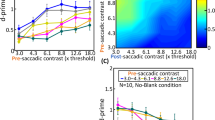Abstract.
Perception of image displacement is suppressed during saccadic eye movements. We probed the source of saccadic suppression of displacement by testing whether it selectively affects chromatic- or luminance-based motion information. Human subjects viewed a stimulus in which chromatic and luminance cues provided conflicting information about displacement direction. Apparent motion occurred during either fixation or a 19.5° saccade. Subjects detected motion and discriminated displacement direction in each trial. They reported motion in over 90% of fixation trials and over 70% of saccade trials. During fixation, the probability of perceiving the direction carried by chromatic cues decreased as luminance contrast increased. During saccades, subjects tended to perceive the direction indicated by luminance cues when luminance contrast was high. However, when luminance contrast was low, subjects showed no preference for the chromatic- or luminance-based direction. Thus magnocellular channels are suppressed, while stimulation of parvocellular channels is below threshold, so that neither channel drives motion perception during saccades. These results confirm that magnocellular inhibition is the source of saccadic suppression.
Similar content being viewed by others
Author information
Authors and Affiliations
Additional information
Electronic Publication
Rights and permissions
About this article
Cite this article
Anand, S., Bridgeman, B. An unbiased measure of the contributions of chroma and luminance to saccadic suppression of displacement. Exp Brain Res 142, 335–341 (2002). https://doi.org/10.1007/s00221-001-0937-0
Received:
Accepted:
Issue Date:
DOI: https://doi.org/10.1007/s00221-001-0937-0




